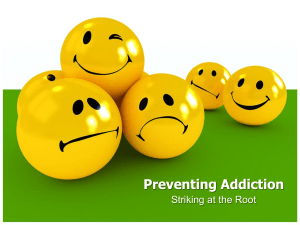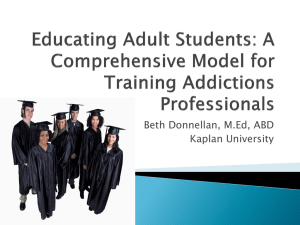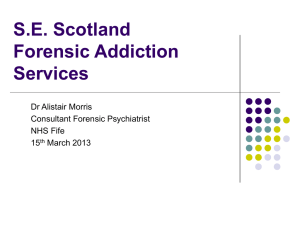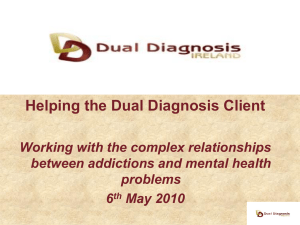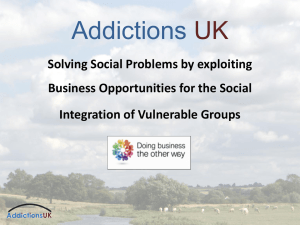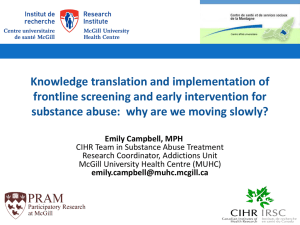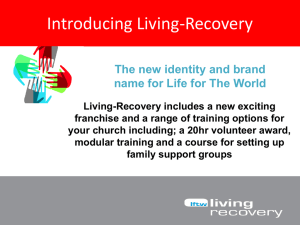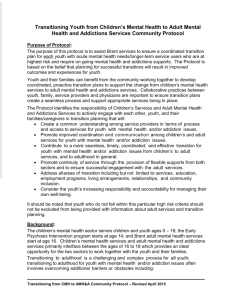A System: Family Perspective on Addictions
advertisement
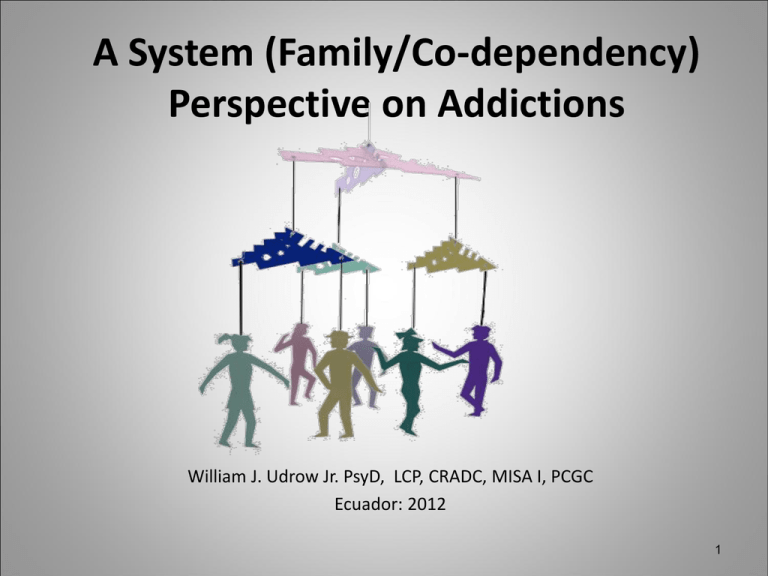
A System (Family/Co-dependency) Perspective on Addictions William J. Udrow Jr. PsyD, LCP, CRADC, MISA I, PCGC Ecuador: 2012 1 A System: Family Perspective on Addictions: U.S.A Data Combined data from 2002 to 2007 indicate that over 8.3 million children under 18 years of age (11.9 percent) lived with at least one parent who was dependent on or abused alcohol or an illicit drug during the past year Of these, almost 7.3 million (10.3 percent) lived with a parent who was dependent on or abused alcohol, and about 2.1 million (3.0 percent) lived with a parent who was dependent on or abused illicit drugs About 5.4 million children under 18 years of age lived with a father who met the criteria for past year substance dependence or abuse, and 3.4 million lived with a mother who met the criteria. (NSDUH, 2009) 2 A System: Family Perspective on Addictions: U.S.A Data The National Survey of Substance Abuse Treatment Services (N-SSATS) is an annual survey of all facilities in the United States, both public and private, that provide substance abuse treatment. In 2000, the 13,428 facilities responding to the N-SSATS were asked about the provision of 26 services, grouped into five types: assessment, substance abuse therapy and counseling, testing, transitional, and other. In the substance abuse therapy and counseling domain 78% of the facilities provided “Family Counseling.” (DASIS, 2003). 3 A System: Family Perspective on Addictions Like machines, organizations, oak trees and bodies, families are systems. Each system is made up of components parts that are linked together in a particular way to accomplish a common purpose. In a family the components are the members. Family components/members include: mother, father, children, siblings, extended family living at home, stepparents, even an absent or deceased person may continue to be a “member” and in some cultures close friends and neighbors can be considered members. (Wegscheider-Cruse, 1989). 4 A System: Family Perspective on Addictions Everyone whose life touches the alcoholic/addicted person is in one way or another affected. The direct consequences fall on the members of the immediate family. Anyone who shares their life with an addicted person. Member of a family cannot so easily turn their back on the addictive person’s problems. Generally, members choose to adapt to the addictive persons behavior/illness. Children have no opportunity for choice, they tend to suffer the consequences of the addicted persons behaviors/illness. Research on children of alcoholics has found that they are often neglected and victims of physical or sexual abuse. (Kaufman & Pattison, 1981) 5 A System: Family Perspective on Addictions Family: Flexible versus Rigid Rules. Rigid Rules: Makes no allowance for differences in people or circumstances. Discourage change, seeing it as a potential threat to the status quo (homeostasis). Flexible Rules: Appreciation for differences in circumstances and family member’s needs. Encourage change and potential source of growth. 6 A System: Family Perspective on Addictions Family: Open and Closed Systems. Open System: Appreciates free flow of communication. Each family member feels free to negotiate personal needs without paying a price. Closed System: Family members are walled off from one another so that they cannot interact. Information and feelings are not shared. Does not admit communication from outside sources. 7 A System: Family Perspective on Addictions Rules in Substance Using Family Rule: The Dependent’s use of chemicals is the most important thing in the family’s life. Family members arrange to be or not to be at home in order to avoid the dependent’s fury of possible embarrassment in front of their friends. 8 A System: Family Perspective on Addictions Rules in Substance Using Family Rule: Chemicals is not the cause of the family’s problems. The dependent tends to blame someone else for their using. The scapegoat may be a child in trouble or a job the dependent does not like—anything. The scapegoat often goes along with the delusion and is overwhelmed with guilt and feelings of worthlessness. Someone or something else caused the substance users dependency; the dependent is not responsible. 9 A System: Family Perspective on Addictions Rules in Substance Using Family Rule: The status quo must be maintained at all cost. Rigid rules and a closed system tend to maintain homeostasis. When the dependent is the rule-maker they make sure the family system stay rigid enough to protect their drug using behaviors. Outside input(counselor/clinician) is discouraged as it may challenge the status quo. 10 A System: Family Perspective on Addictions Rules in Substance Using Family Rule: Everyone in the family must be an “enabler.” Family members are quick to say that they would do anything to get the dependent to stop. But unconsciously they continue to “enable” the dependent. Family member will make alibi for the dependent and these actions will be defended on the grounds of love or family honor and loyalty. 11 A System: Family Perspective on Addictions Rules in Substance Using Family Rule: No one may discuss what is really going on in the family, either with one another or with outsiders. Maintaining a rigid and closed system of communication. The rule-makers tries to avoid letting outsiders know about family affairs—specifically, the degree of the dependency and the magnitude of its impact on family members (i.e., wife, husband, children…). Also this system avoids access to new information and advice from outsiders. 12 A System: Family Perspective on Addictions Rules in Substance Using Family Rule: No one may say what they are really feeling. This is a standard rule in severely dysfunctional families. Communication among family members is severely hampered. Eventually as the disease advances the dependent completely represses their own feelings. The dependent begins to experience internal contradictory messages. 13 A System: Family Perspective on Addictions Roles in a substance using family: • • • • • • The Dependent The Enabler The Hero The Scapegoat The Mascot The Lost Child 14 15 A System: Family Perspective on Addictions The Dependent: This is the family member that uses chemicals whose primary motivating feeling is shame. As the Dependent recovers, they gradually learns to trust, first within the family, then in a widening circle of relationships. Eventually they find a deeper meaning and purpose in life. 16 A System: Family Perspective on Addictions The Enabler: They too have suffered, and carry a burden of shame and guilt. They, however, are different. They feel shame for what they see as their problem, guilt for their inability to change the dependent one. This person needs to be taught that the controlling purpose in life which has been to change the Dependents’ behavior is an impossible dream. This person will exhibit traits of codependent. 17 A System: Family Perspective on Addictions The Hero: This is the child who is “9 going on 40.” Their self-worth is higher than the others’, and their pain may be less acute. Until now the Hero has occupied a special and honored place in the family. When they give up their role, they must also give up being the most special. 18 A System: Family Perspective on Addictions The Scapegoat: This is the child that the family feels ashamed of—and the most emotionally honest child in the family. They act out the tension and anger the family ignores. This child provides distraction from the real issues in the family. The scapegoat usually has trouble in school because they get attention the only way they know how—which is negatively. 19 A System: Family Perspective on Addictions The Mascot: Some Mascots can be a delightful addition to the treatment process, adding a needed light touch with their sense of humor. This child takes responsibility for the emotional well-being of the family. They become the families ‘social director’ and clown, diverting the family’s attention from the pain and anger. 20 A System: Family Perspective on Addictions Lost Child: This child escapes by attempting to be invisible. They daydream, fantasize, read a lot of books or watch a lot of TV. They deal with reality by withdrawing from it. They deny that they have any feelings and “don’t bother getting upset.” 21 A System: Family Perspective on Addictions Primary Care: 1. To let down the wall of defensiveness: Family members are not able to feel their true feelings. A caring clinician/counselor can be the beginning of honest communication. Listening alone can often melt rigit defenses in a single session. 2. To let the pain emerge: People from a substance abusing family seem to have a very difficult time distinguishing one emotion (hurt, rage, hate, shame, grief, loneliness, fear, jealousy, & guilt) from another. Putting labels on these feelings is a beginning. 22 A System: Family Perspective on Addictions Primary Care: 3. To begin to experience some positive feeling: Allowing people in the family to feel their pain will make it possible for the person in primary care to begin feeling positive emotions as well. 4. To accept the family illness and one’s own part in it: Education featuring lectures, films, or visits from substance abusers who have successfully re-formed. AlAnon & FA. 23 A System: Family Perspective on Addictions Primary Care 5. To make a personal commitment to an ongoing recovery program for the family and for themselves: It has taken years for the family’s disease to develop to its present crisis, and it will take a long time and a lot of hard work to create a new, health family in its place. The work begun in primary care must go on long after supervised treatment is over. 24 A System: Co-Dependent “A codependent person is one who has let another person’s behavior affect him or her, and who is obsessed with controlling that person’s behavior.” (Beattie, 1992) 25 A System: Co-Dependent • Codependency occurs when another individual, perhaps the addict's spouse or family member, is controlled by the addict's addictive behavior. Codependents become codependent because they have learned to believe that love, acceptance, security, and approval are contingent upon taking care of the addict in the way the addict wishes. In their decision making process, they allow the addict to define reality. 26 A System: Co-Dependent • Codependency. Unfortunately, this excessively care giving behavior tends to foster even more dependency on the part of the addict. Some codependents are adult children of alcoholics or addicts and their codependent behavior is the result of growing up in the environment of addiction. • Because the codependent “needs to be needed” they may impede the progress of the recovering person as the recovering person begins to become more independent. (Lawson & Lawson, 1989) 27 28 A System: Co-Dependent Symptoms: • controlling behavior • distrust • perfectionism • avoidance of feelings • intimacy problems • caretaking behavior • hyper-vigilance (a heightened awareness for potential threat/danger) • physical illness related to stress 29 A System: Co-Dependent Difficulties: • Difficulty in accurately identifying feelings • Difficulty in expressing feelings • Difficulty in forming or maintaining close or intimate relationships • Perfectionism—unrealistic expectations for self and others • Rigidity in behavior and/or attitudes 30 A System: Co-Dependent • Treatment Healing takes time and hard work, but talking with other codependents and seeing a therapist are two of the best ways to start the recovery process. Therapy: Treatment may consist of individual therapy, group therapy and couples and family therapy. A clinical social worker, psychologist or psychiatrist with experience treating codependents and families of addicts can help a codependent person identify and discuss the feelings, thoughts and behaviors that they and others find troubling. 31 A System: Co-Dependent • Treatment Twelve-step groups: Many advocates of the codependency theory view codependency as a type of addiction. Therefore, they maintain that codependents can overcome their symptoms with a 12-step process similar to that used by Alcoholics Anonymous. Twelve-step recovery programs bring codependents together as a group to talk about their struggles and share hope and experiences. The 12step recovery process involves spirituality and is nondenominational. Codependents Anonymous meetings can provide participants with a great source of emotional and practical support. 32 Reference Beattie, M. (1992). Codependent No More. Center City, Minnesota. Hazelden Educational Materials Drug and Alcohol Services Information System (DASIS) (2003). http://www.samhsa.gov/data/2k3/ServicesTX/servicesTX.htm Kaufman, E. & Pattison, E. M. (1981). Differential methods of family therapy in the treatment of alcoholism, Journal of Studies on Alcohol, 42, 951-971. 1979. Lawson, G. W. & Lawson, A. W. (1989). Alcoholism & Substance Abuse: In Special Populations. San Diego, California. An Aspen Publication, Inc. National Survey on Drug Use and Health (2009): The NSDUH Report: Children Living with Substance-Dependent or Substance Abusing Parents: 2002 to 2007. http://www.samhsa.gov/data/2k9/SAparents/SAparents.htm Wegscheider-Cruse, S. (1989). Another Chance: Hope and Health for the Alcoholic Family. Palo, Alto, California. Science and Behavior Books, Inc. 33
